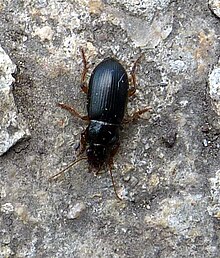Harpalus latus
| Harpalus latus | |
|---|---|

| |
| Scientific classification | |
| Domain: | Eukaryota |
| Kingdom: | Animalia |
| Phylum: | Arthropoda |
| Class: | Insecta |
| Order: | Coleoptera |
| Family: | Carabidae |
| Subfamily: | Harpalinae |
| Tribe: | Harpalini |
| Genus: | Harpalus |
| Species: | H. latus
|
| Binomial name | |
| Harpalus latus | |
| Synonyms[1] | |
| |
Harpalus latus is a ground beetle in the subfamily Harpalinae that can be found in Europe, Armenia, Georgia, Kazakhstan, Mongolia, and North Korea.[1] Found in Ontario Canada
Description[edit]
The species is 10.2 millimetres (0.40 in) in length.[1] Its anal tube is twice as long as its cerci, approximately 0.65–0.7 millimetres (0.026–0.028 in). Its head is 1.5 millimetres (0.059 in) long and broad. It has forwardly extending cervical grooves which are long too. The species nasal is similar to Harpalus rufipes, but it differs in the number of teeth which are crenellated on the median part. The second segment of antenna have 2 setae while it has none on the first one. Its tergum have 4 and 6 setae which appear in transverse rows. It has 2 teeth in front of retinaculum which are directed inward. It also has 4 large teeth on the first instar egg-bursters.[2] Both antennas and pedipalp are rufous and ferruginous.[3]
Distribution[edit]
In Great Britain, it can be found in Bidston Hill and Heswall Heath.[4] In 1901 it was recorded from Valentia island.[5]
Habitat[edit]
Its natural habitat is forests, heath[6] sand[7] and gravel-pits.[3]
References[edit]
- ^ a b c "Harpalus latus (Linnaeus, 1758)". Catalogue of Life. Retrieved 2023-04-08.
- ^ Martin L. Luff (1993). The Carabidae (Coleoptera) Larvae of Fennoscandia and Denmark. Vol. 27. New York, Leiden: E. J. Brill. p. 150. ISBN 90-04-09836-4. ISSN 0106-8377.
{{cite book}}:|journal=ignored (help) - ^ a b James Francis Stephens (1828). Illustrations of British Entomology, Or a Synopsis of Indigenous Insects. Vol. 2. p. 143.
- ^ "Proceedings of the Liverpool Biological Society: 1886-1888". 1–2. Liverpool Biological Society. 1887: 196.
{{cite journal}}: Cite journal requires|journal=(help) - ^ "The Entomologist's Monthly MagazineZ". 37. Davis: University of California. 1901: 272.
{{cite journal}}: Cite journal requires|journal=(help) - ^ Johann Baumgärtner; Pietro Brandmayr; Bryan F. J. Manly (1998). Insect Management and Conservation. Balkema, Rotterdam: A. A. Balkema. p. 198. ISBN 90-5410-930-0.
- ^ Transactions of the Royal Entomological Society of London. Vol. 2. London: Royal Entomological Society of London. 1840. p. 59.
External links[edit]
- Harpalus latus on Flickr
- Harpalus latus on Pinterest
